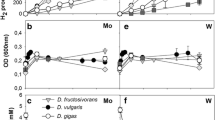Abstract
Washed cells of Desulfovibrio vulgaris strain Marburg oxidized H2, formate, lactate or pyruvate with sulfate, sulfite, trithionate, thiosulfate or oxygen as electron acceptor. CuCl2 as an inhibitor of periplasmic hydrogenase inhibited H2 and formate oxidation with sulfur compounds, and lactate oxidation in H2-grown, but not in lactate-grown cells. H2 oxidation was sensitive to O2 concentrations above 2% saturation. Carbon monoxide inhibited the oxidation of all substrates tested. Additions of micromolar H2 pulses to cells incubated in KCl in the presence of various sulfur compounds (reductant pulse method) resulted in a reversible acidification. This proton release was stimulated by thiocyanate, methyl triphenylphosphonium (MTPP+) or valinomycin plus EDTA, and completely inhibited by the uncoupler carbonylcyanide m-chlorophenylhydrazone (CCCP), CuCl2 or carbon monoxide. The extrapolated H+/H2 ratios obtained with sulfate, sulfite, trithionate or thiosulfate varied from 1.0 to 1.7. Micromolar additions of O2 to cells incubated in the presence of excess of electron donor (oxidant pulse method) caused proton translocation with extrapolated H+/H2 ratios of 3.9 with H2, 1.6 with lactate and 2.4 with pyruvate. Since a periplasmic hydrogenase can release at maximum 2 H+/H2, it is concluded that D. vulgaris is able to generate a proton gradient by vectorial proton translocation across the cytoplasmic membrane and by extracellular proton release by a periplasmic hydrogenase.
Similar content being viewed by others
References
Aketagawa J, Kobayashi K, Ishimoto M (1983) Characterization of periplasmic hydrogenase from Desulfovibrio vulgaris Miyazaki K. J Biochem 93: 755–762
Badziong W, Thauer RK (1980) Vectorial electron transport in Desulfovibrio vulgaris (Marburg) growing on hydrogen plus sulfate as the sole energy source. Arch Microbiol 125: 167–174
Cypionka H, Dilling W (1986) Intracellular localization of hydrogenase in Desulfotomaculum orientis. FEMS Microbiol Lett 36: 257–260
Cypionka H, Pfennig N (1986) Growth yields of Desulfotomaculum orientis with hydrogen in chemostat culture. Arch Microbiol 143: 396–399
Dilling W, Cypionka H (1990) Aerobic respiration in sulfate-reducing bacteria. FEMS Microbiol Lett 71: 123–128
Fitz RM, Cypionka H (1989) A study on electron transport-driven proton translocation in Desulfovibrio desulfuricans. Arch Microbiol 152: 369–376
Fitz RM, Cypionka H (1990) Formation of thiosulfate and trithionate during sulfite reduction by washed cells of Desulfovibrio desulfuricans. Arch Microbiol 154: 400–406
Hatchikian EC, Chaigneau M, LeGall J (1976) Analysis of gas production by growing cultures of three species of sulfate-reducing bacteria. In: Schlegel HG, Gottschalk G, Pfennig N (eds) Microbiol production and utilization of gases. Goltze, Göttingen, pp 109–118
Kobayashi K, Hasegawa H, Takagi M, Ishimoto M (1982) Proton translocation associated with sulfite reduction in a sulfate-reducing bacterium, Desulfovibrio vulgaris. FEBS Lett 142: 235–237
Lax E (1967) Löslichkeit von Gasen in Flüssigkeiten. In: D'Ans J, Lax E (eds) Taschenbuch für Chemiker und Physiker. Springer, Berlin Heidelberg New York, pp 1203–1211
Lupton FS, Conrad R, Zeikus JG (1984) Physiological function of hydrogen metabolism during growth of sulfidogenic bacteria on organic substrates. J Bacteriol 159: 843–849
Odom JM, Peck HD (1981) Hydrogen cycling as a general mechanism for energy coupling in the sulfate-reducing bacteria, Desulfovibrio sp. FEMS Microbiol Lett 12: 47–50
Odom JM, Peck HD (1984) Localization of dehydrogenases, reductases, and electron transfer components in the sulfate-reducing bacterium Desulfovibrio gigas. J Bacteriol 147: 161–169
Odom JM, Wall JD (1987) Properties of a hydrogen-inhibited mutants of Desulfovibrio desulfuricans ATCC 27774. J Bacteriol 169: 1335–1337
Pankhania JP, Spormann AM, Hamilton WA, Thauer RK (1988) Lactate conversion to acetate, CO2 and H2 in cell suspensions of Desulfovibrio vulgaris (Marburg): indications for the involvement of an energy driven reaction. Arch Microbiol 150: 26–31
Peck HD, LeGall J, Lespinat PA, Berlier Y, Fauque G (1987) A direct demonstration of hydrogen cycling by Desulfovibrio vulgaris employing membrane-inlet mass spectrometry. FEMS Microbiol Lett 40: 295–299
Scholes P, Mitchell P (1970) Respiration-driven proton translocation in Micrococcus denitrificans. Bioenergetics 1: 309–323
Tsuji K, Yagi T (1980) Significance of hydrogen burst from growing cultures of Desulfovibrio vulgaris, Miyazaki, and the role of hydrogenase and cytochrome c 3 in energy production system. Arch Microbiol 125: 35–42
Author information
Authors and Affiliations
Rights and permissions
About this article
Cite this article
Fitz, R.M., Cypionka, H. Generation of a proton gradient in Desulfovibrio vulgaris . Arch. Microbiol. 155, 444–448 (1991). https://doi.org/10.1007/BF00244959
Received:
Accepted:
Issue Date:
DOI: https://doi.org/10.1007/BF00244959




